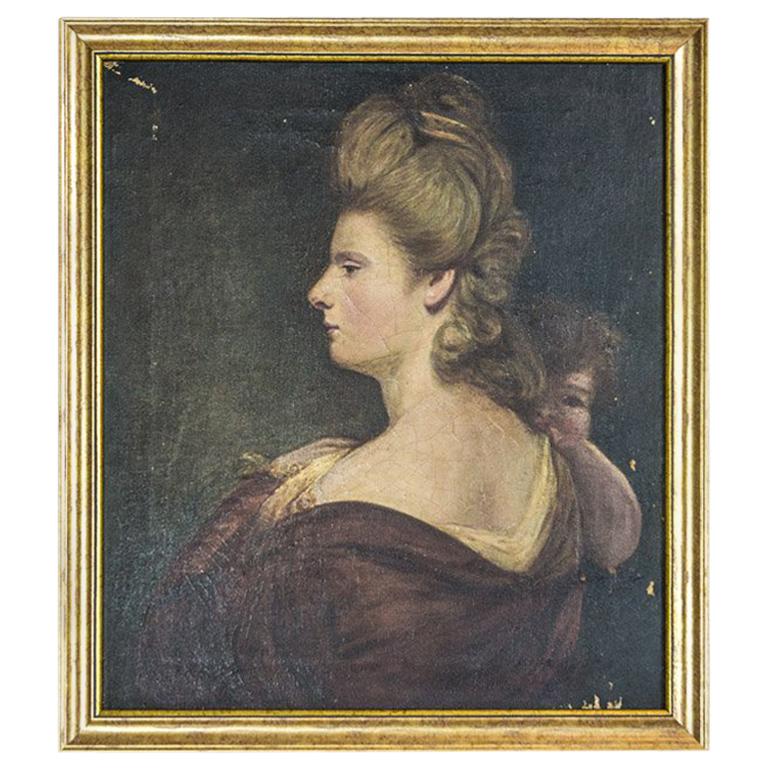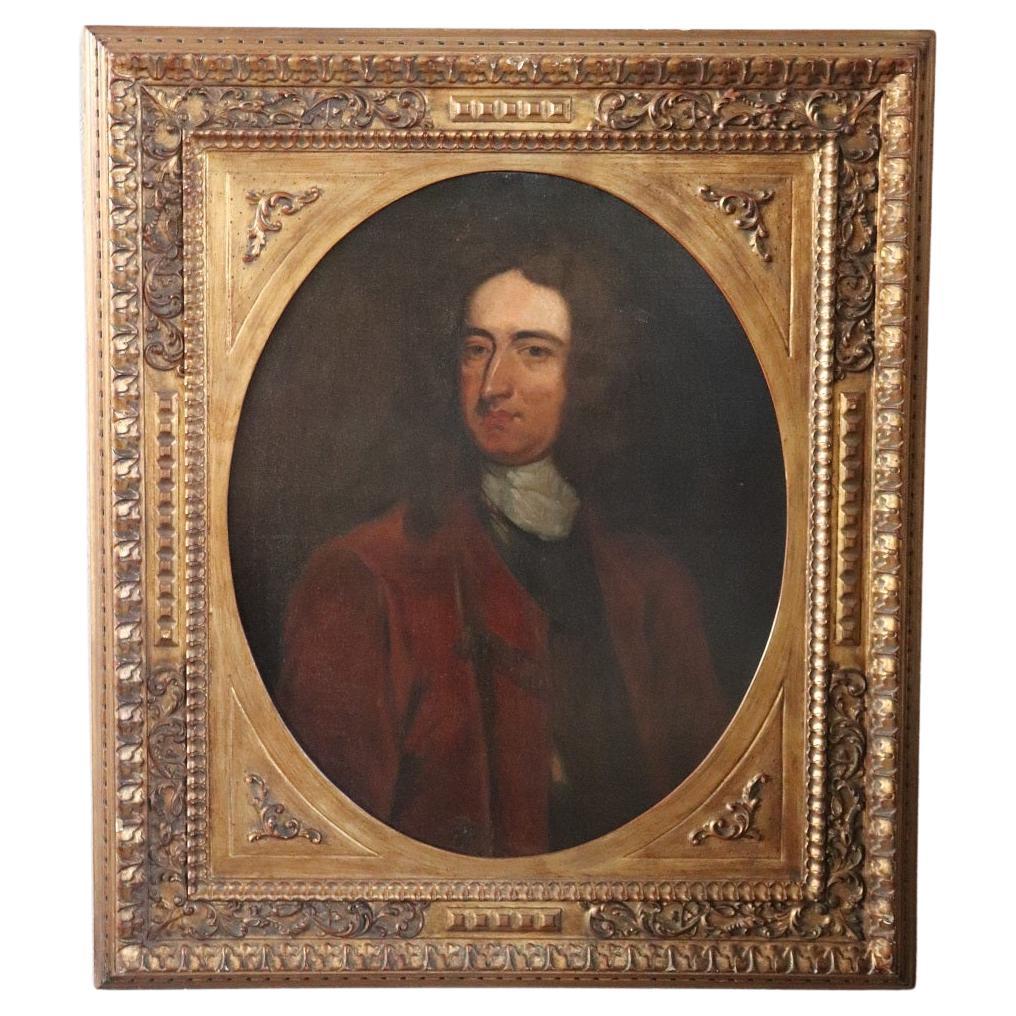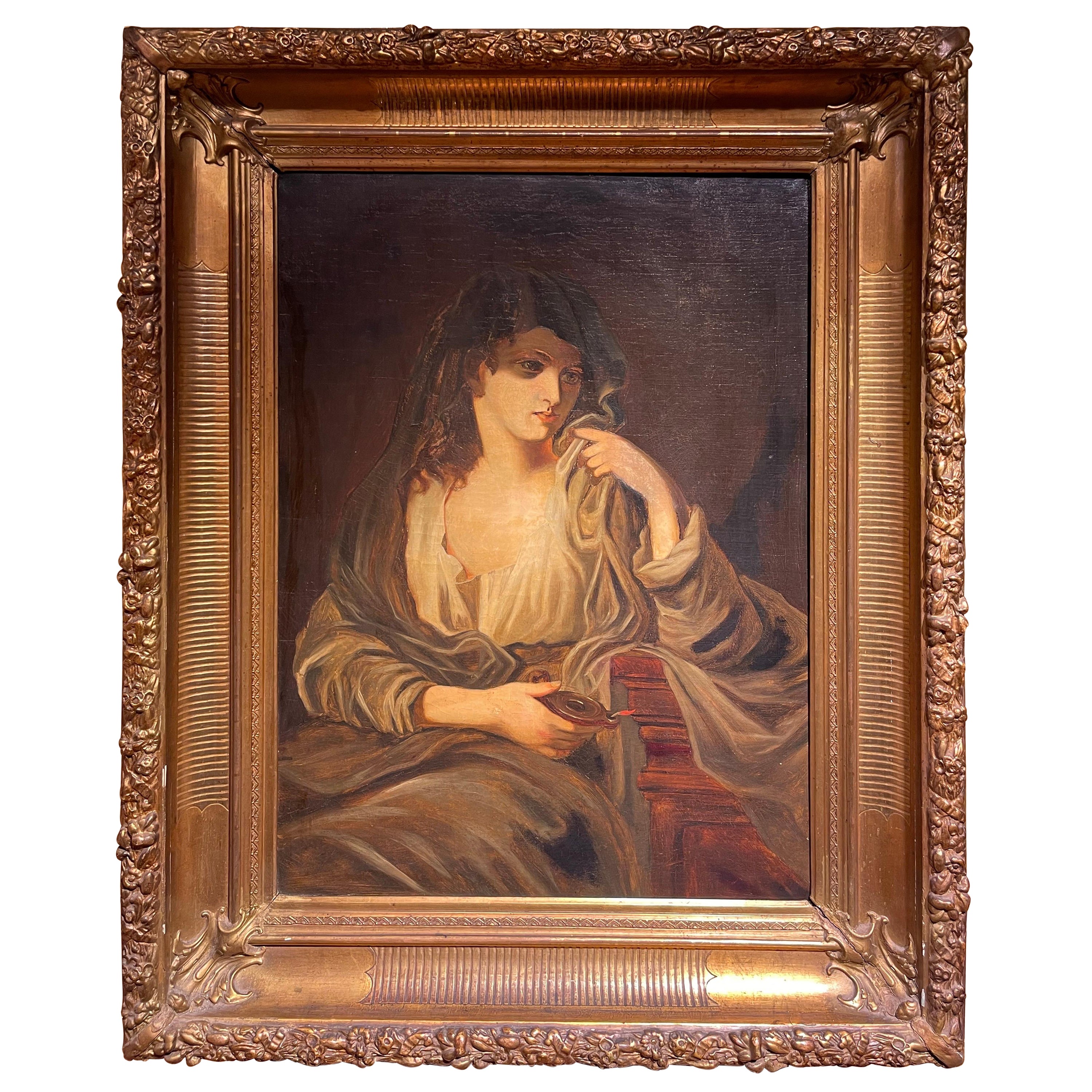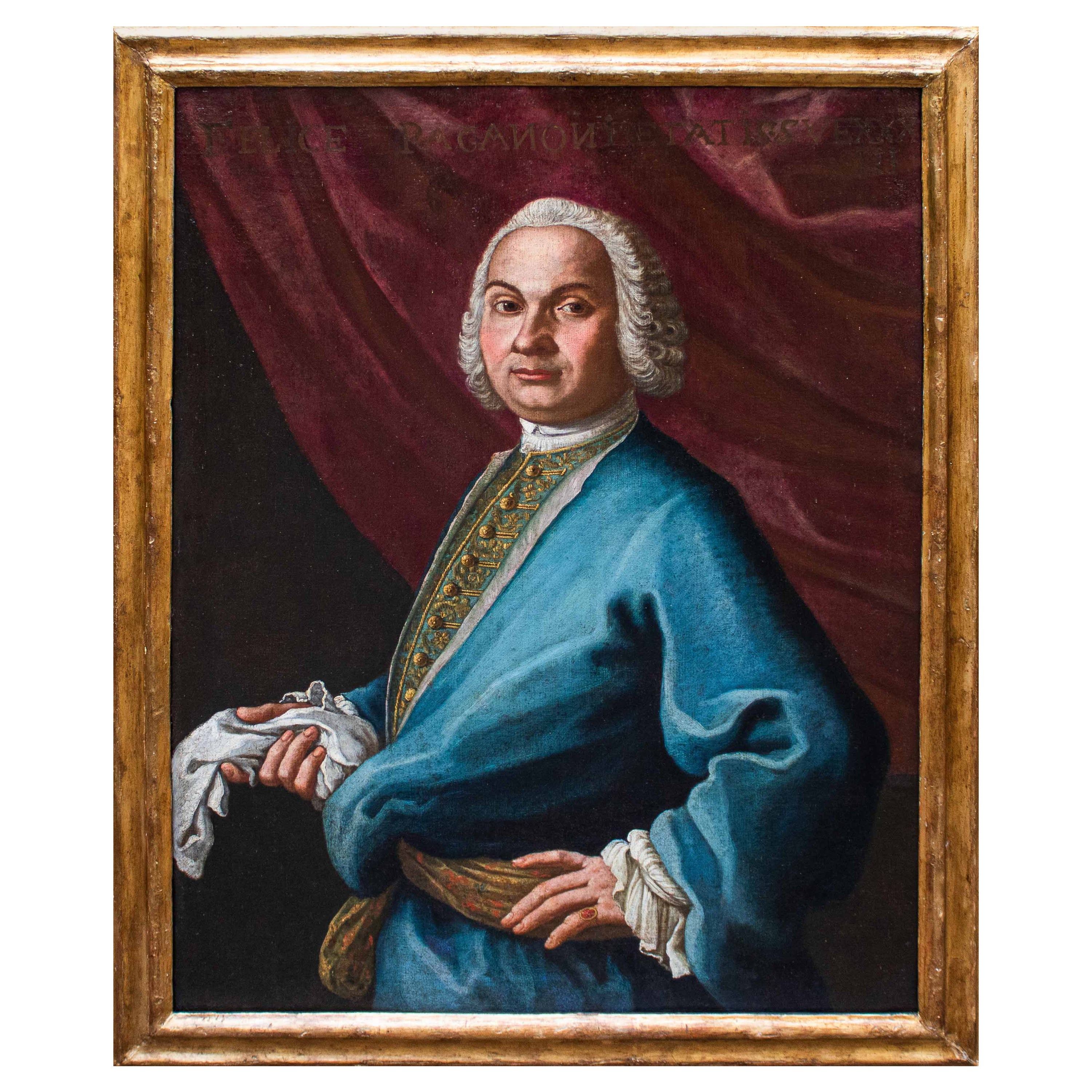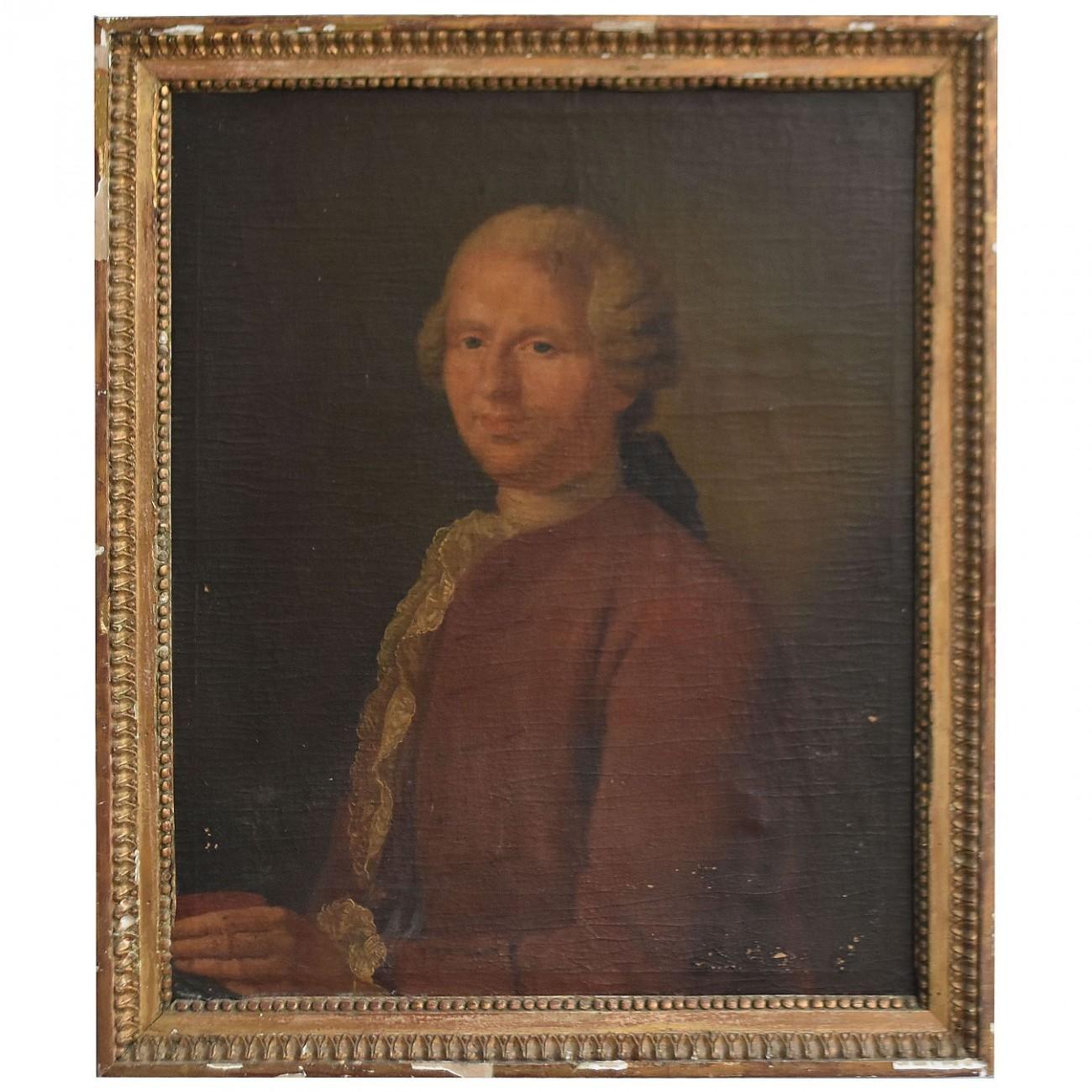Items Similar to 18th-19th Century Portrait of Antonio Canova Painting Oil on Canvas by Lampi
Want more images or videos?
Request additional images or videos from the seller
1 of 6
18th-19th Century Portrait of Antonio Canova Painting Oil on Canvas by Lampi
About the Item
Giovanni Battista Lampi (Romanian, 1751 - Vienna, 1830) Portrait of Antonio Canova
Oil on canvas, 51 x 41 cm - with frame 70 x 59 cm
Throbbing restlessness of the genius, mixed with noble grandeur betrayed by the very setting of the portrait, painted frontally, without distractions, with a dark backdrop from which only the face of the artist stands out. These are the virtues that Giovanni Battista Lampi (Romeno, 1751 - Vienna 1830) outlined in the present portrait of his colleague Antonio Canova (Possagno, 1757 - Venice, 1822). The irrepressible nobility that emanates from the shining eyes of Canova, whose face is cut by a grazing light that inflames the jabot and cloak of the dress, metaphorically the distinguished admiration enjoyed at the time by the eclectic artist, whose effigy returns in many portraits of contemporaries and also in both pictorial and sculptural self-portraits.
With this portrait Lampi intended to pay a heartfelt homage to a spirit of soul akin to him, engaged in the aristocratic age of the courts but conscious investigator of intellectual morality. The enthusiastic consensus that Canova, the absolute protagonist of the neoclassical season, was able to awaken in his contemporaries is punctually recognizable in this portrait, a compendium of absolute modern grace translated by means of the ancient as an excellent aesthetic ideal.
Following his apprenticeship in Salzburg, first in the workshop of FX König, connected to the princely court, then by FN Streicher, Lampi began a thriving automaton portrait activity which led him to the most renowned imperial courts. The theoretical basis of his portraiture was formed by the lessons of G. Cignaroli as well as of F. Lorenzi, still in Tiepolo's manner, learned in the Scaligero capital. In 1779 the artist was in Innsbruck, protected by the governor Gottfried von Heister, where he painted the portrait of Archduchess Maria Elisabeth of Habsburg-Lorraine (1781, Damenstift of Innusbruck) who favored his orders within the Austrian family. He then moved to Vienna in 1783, welcomed by the Josephan cultural policy, in which he painted the life-size portrait of Emperor Joseph II with the insignia of the Golden Fleece. Following his service at the courts of Warsaw, from 1788, and of Moldavia, the artist reached the coveted Saint Petersburg in 1792, where for six years he was the eminent representative of Tsarist absolutism (remember the portrait of Platon Zubov in the guise of admiral, now in the Hermitage). Returning to Vienna, he took leave of his painting activity with a self-portrait at the easel (Belvedere Museum, Vienna, 1828), passing the baton to his son Giovanbattista, not without having first immortalized the effigy of Canova in another painting, in 1806 ( today Liechtenstein, Princely Collection). where for six years he was the eminent representative of Tsarist absolutism (remember the portrait of Platon Zubov as an admiral, now in the Hermitage). Returning to Vienna, he took leave of his painting activity with a self-portrait at the easel (Belvedere Museum, Vienna, 1828), passing the baton to his son Giovanbattista, not without having first immortalized the effigy of Canova in another painting, in 1806 ( today Liechtenstein, Princely Collection). where for six years he was the eminent representative of Tsarist absolutism (remember the portrait of Platon Zubov as an admiral, now in the Hermitage). Returning to Vienna, he took leave of his painting activity with a self-portrait at the easel (Belvedere Museum, Vienna, 1828), passing the baton to his son Giovanbattista, not without having first immortalized the effigy of Canova in another painting, in 1806 ( today Liechtenstein, Princely Collection).
- Dimensions:Height: 27.56 in (70 cm)Width: 23.23 in (59 cm)Depth: 1.97 in (5 cm)
- Materials and Techniques:
- Place of Origin:
- Period:
- Date of Manufacture:18th-19th Century
- Condition:Refinished. Wear consistent with age and use. The painting has been cleaned.
- Seller Location:Milan, IT
- Reference Number:1stDibs: LU5918226763192

About the Seller
5.0
Vetted Seller
These experienced sellers undergo a comprehensive evaluation by our team of in-house experts.
Established in 2000
1stDibs seller since 2021
25 sales on 1stDibs
Typical response time: 10 hours
More From This SellerView All
- 18th-19th Century Interior of the Church Painting Oil on CanvasLocated in Milan, ITAttr. to Giovanni Migliara (Alessandria, 1785 - Milan, 1837) Interior of the church: the arrest of the nun of Monza Oil on canvas, 79 x 61 cm With frame 104 x 85 cm The painting in question can be attributed by subject and definition to Giovanni Migliara (1785 - 1837), a painter originally from Alessandria. His training was particular and eclectic. The son of a cabinetmaker, he was in the workshop of the sculptor Luigi Zuccoli...Category
Antique Late 18th Century Italian Paintings
MaterialsCanvas
- 18th Century Portrait of Felice Paganoni Painting Oil on CanvasLocated in Milan, ITAttributed to Giacomo Ceruti (Milan, 1698-1767) Portrait of Felice Paganoni Oil on canvas, 98.5 x 73 cm With frame, 109 x 85 x 4 cm "Felice Pag...Category
Antique 18th Century Italian Paintings
MaterialsCanvas
- 19th Century Portrait of a Gentleman Painting Oil on Canvas Lombard SchoolLocated in Milan, IT19th century, Lombard school Portrait of a Gentleman Oil on canvas, 92 x 71 cm With frame 107 x 87 cm The elegant portrait in question depicts a carefully dressed gentle...Category
Antique 19th Century Italian Paintings
MaterialsCanvas
- 17th - 18th Century Portrait of Guy Painting Oil on Canvas by Area of AmorosiBy Antonio AmorosiLocated in Milan, ITCircle of Antonio Amorosi (Comunanza, 1660 - Rome, 1738) Portrait of young people Oil on canvas, 87 x 67 cm The painting depicting this portrait was made by an artist activ...Category
Antique Late 17th Century Italian Paintings
MaterialsCanvas
- 18th Century Portraits of Women Couple of Paintings in Oil on Canvas by BertoliLocated in Milan, ITAntonio Bertoli (active between 1829 - 1842) Portraits of women (2) Oil on canvas, 41.5 x 31 cm With frame 52 x 42.5 cm Signed below A. Bertoli The two portraits examined here are by the hand of the artist Antonio Bertoli, a painter active in Florence between 1829 - 1842. He trained at the Florentine Academy, where in 1832 he obtained the prize for the nude in drawing. At the academic exhibitions of the following years he exhibited mainly portraits, including a representation of Nicolò Macchiavelli executed in 1837. An eclectic artist, he experimented with different genres: for the Villa Puccini di Scornio in Pistoia, in 1838, he was commissioned to create a history picture, The death of Francesco Ferrucci (Pistoia, Civic Museum), inspired by an episode of the novel Siege of Florence by Francesco Domenico Guerrazzi. Instead, two religious paintings date back to the 1840s: Christ chasing the merchants from the Temple and a Virgin Mary, In the portraits analyzed Bertoli depicts two half-length women taken from a foreshortening and a frontal in close pose, characterized by very similar Mediterranean features. In the first painting the woman, taken from the front, looks directly at the viewer. The wavy hair is decorated with a colorful violet and is partially covered by a white veil...Category
Antique 19th Century Italian Paintings
MaterialsCanvas
- 19th Century Portrait of Tiziano and Rembrandt Couple of Paintings Oil on CanvasLocated in Milan, IT19th century Portrait of Tiziano Vecellio and Rembrandt Measures: (2) Oil on canvas, 25 x 18.5 cm Frame 46 x 37 cm The two portraits depicting the artists Tiziano Vecellio and Rembrandt are to be counted among the reproductions of those famous self-portraits made by the two painters throughout their careers. As far as Titian is concerned, the artist creates numerous self-portraits that shoot him in different ages of his life and in different poses from time to time. An example is the one kept in the Prado Museum (Tiziano Vecellio, Self-portrait, 1560, oil on canvas, 86 × 65 cm, Museo del Prado, Madrid), which portrays the now elderly master, as in the present case. The thick white beard reaches almost to the chest, depicted almost in profile, while here the bust is frontal and the face turned three-quarters; his gaze is then turned to the outside of the painting and his expression seems tired and thoughtful. The broad forehead is uncovered and cut by a tight black bonnet from which no hair comes out. A thin white collar separates the face from the rest of the body dressed in an elegant and sober black dress, just like in this portrait. The figure clearly emerges from the background devoid of objects or furnishings, so that nothing distracts our gaze from the image of the famous artist who thus wants to be remembered. Another example is the self-portrait in Berlin (Self-portrait, 1552, 96 x 75 cm, Staatliche Museen, Berlin), which depicts the elderly artist, but decorated with a rich dress and placed in a physical space. Finally, the lost self-portrait in oil on paper, cited by Vasari in his Lives in 1545, keeps a low profile, as evidenced by the rather modest dress...Category
Antique 19th Century Italian Paintings
MaterialsCanvas
You May Also Like
- 19th Century Painting, Oil on Canvas, A Portrait of a WomanLocated in Opole, PLWe present you this oil on canvas, circa the early 19th century, with a portrait of a lady, in profile, holding a baby on her arm. The condition of this piece of art is good. Howeve...Category
Antique Early 19th Century Paintings
MaterialsCanvas
- 18th Century Antique Oil Painting on Canvas Portrait of a GentlemanLocated in Casale Monferrato, ITBeautiful antique oil painting on canvas portrait of a gentleman. Excellent pictorial quality great attention to detail. English school ...Category
Antique 1780s Dutch Paintings
MaterialsCanvas
- Monumental Oil on Canvas Painting / Portrait, 19th CenturyLocated in Berlin, DEMonumental oil on canvas painting / portrait, 19th century High quality oil painting from the 19th century. Wide gold frame. Illustration o...Category
Antique 19th Century Dutch Paintings
MaterialsCanvas
- 18th Century Portrait of a Gentleman Oil on CanvasLocated in Marseille, FR18th century portrait of a gentleman oil on canvas.Category
Antique 18th Century French Louis XVI Paintings
- Portrait, 19th-Century, Oil on CanvasLocated in Munich, DEThis piece is signed by the artist.Category
Antique 19th Century Paintings
MaterialsCanvas, Wood
- 19th Century Portrait / Oil on CanvasLocated in Beirut, LBMid-19th century signed portrait made of oil on canvas, representing a woman or lady form the middle class bourgeoisie. The subject is wearing green clothing with a white collar and ...Category
Antique Mid-19th Century European Paintings
MaterialsStucco, Paint
Recently Viewed
View AllMore Ways To Browse
Nobility Painting
Hand Painted Imperial Furniture
Baton Brown
Imperial Portrait
Antique Painting Easel
Antique Effigy
Neoclassical Vienna
Easel Light
Lighted Easel
Golden Fleece
The Golden Fleece
Golden Fleece Used
Antique Jabot
Elisabeth Of Austria
Elisabeth Ii
Portrait Habsburg
Liechtenstein Painting
Automaton Modern
